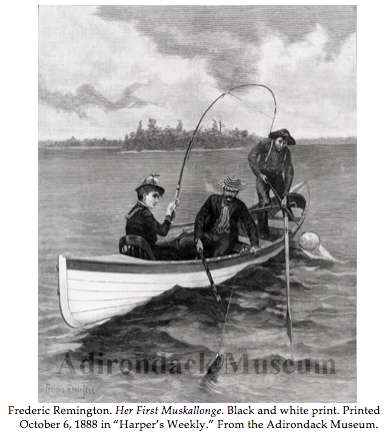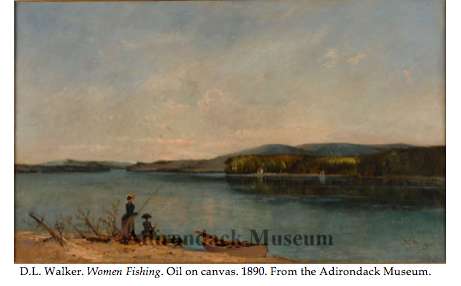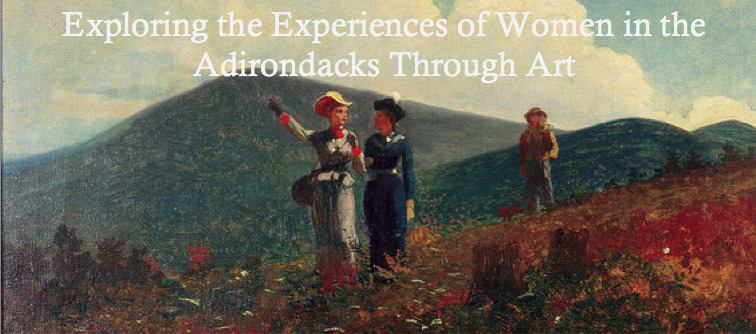
Sandra Weber explains in her book Adirondack Roots: Stories of Hiking, History, and Women that in the mid-nineteenth century it was not at all common for respectable women to explore and experience the wilderness. This is not to say that women did not visit the Adirondacks, but rather that they stayed at boardinghouses and camps while the men hunted and hiked. It was a strongly held belief that it was not proper for women to express athleticism or a desire for adventure.

Even women’s clothing reflected this notion as they wore long skirts, corsets, and high heels, and heavy layers of fabric. While the majority of women did not partake in overly strenuous recreational activities while visiting the Adirondacks, there are several accounts and illustrations that respectively describe and depict women fishing and hunting.
Fishing is the more common scene that depicts women participating in recreational activities. One of these illustrations is a black and white print by Frederic Remington, printed in the October 1888 edition of Harper’s Weekly. The print is entitled Her First Muskallonge. Here, we see a young woman sitting in a guideboat with two men. One of the men is identifiable as a guide due to his outfit and the other man is likely a wealthy tourist, perhaps the woman’s husband or escort. Both of the men are about to assist the woman pull aboard the fish that she has caught. The woman is wearing an outfit that includes a long dress with arm-length sleeves complete with a collar and a hat, clothing that is hardly designed for recreation. In this scene, it is signficant to notice that the woman is accompanied by two men and is not fishing by herself, which would have been deemed less acceptable. In addition, the title, Her First Muskallonge, implies that this recreational activity is a new experience for this woman and is not something that she frequently does.

In a second painting by D.L. Walker, Women Fishing, painted in 1890, we see two women fishing with a boat nearby that they presumably rowed over in. In the case of this painting, there is no male figure in sight, which is fairly unusual and in strong contrast to other prints and paintings of women engaging in recreation. However, similarly to Her First Muskallonge, the women in this scene don garments even more proper and restrictive, adhering to the Victorian fashion standards of the time as seen in the woman standing who wears a long, heavy dress as well as a petticoat and even a bustle.
While fishing was a fairly common activity for women to engage in, hunting was far less practiced as a recreational sport. The Adirondack Museum features only a single print in their collection that features a woman hunting, entitled Miss Diana in the Adirondacks, printed August 1883 as the cover for Harper’s Weekly. Miss Diana stands with a smoking gun and looks across the river at the stag, which she has just shot. In the direct center of the picture plane are men in a boat cheering and approaching her. This illustration, Georgia B. Barnhill explains in Adirondack: Prints and Printmakers, was used as a means to criticize tourists who employed jacking or hounding to procure game, whereas Diana’s fine marksmanship is the more respectable technique.
 This commentary follows the illustration in Harper’s Weekly: “the killing of this particular deer was not the result of an accident, nor was the shot made at such a short range as to render a miss impossible. Assiduous practice and trained both eye and hand,” (Barnhill, 66). In this instance, Miss Diana is being praised for her marksmanship, however this would likely not have been the case had it actually happened. Sandra Weber explains in her book that women were discouraged from partaking in such activities and many local sportsmen were greatly perturbed by women who participated in recreation, especially Thomas Bangs Thorpe who believed that there was nothing in a women’s education that would allow her to appreciate the wilderness. So in the case of this magazine cover, it could be interpreted that this image featuring a young woman with a fine shot would be a means to deter men from employing methods such as hounding. If Miss Diana, a young woman in a full and formal Victorian costume, can shoot a deer with just a rifle, than so could any man.
This commentary follows the illustration in Harper’s Weekly: “the killing of this particular deer was not the result of an accident, nor was the shot made at such a short range as to render a miss impossible. Assiduous practice and trained both eye and hand,” (Barnhill, 66). In this instance, Miss Diana is being praised for her marksmanship, however this would likely not have been the case had it actually happened. Sandra Weber explains in her book that women were discouraged from partaking in such activities and many local sportsmen were greatly perturbed by women who participated in recreation, especially Thomas Bangs Thorpe who believed that there was nothing in a women’s education that would allow her to appreciate the wilderness. So in the case of this magazine cover, it could be interpreted that this image featuring a young woman with a fine shot would be a means to deter men from employing methods such as hounding. If Miss Diana, a young woman in a full and formal Victorian costume, can shoot a deer with just a rifle, than so could any man.
Much more representative of the general public’s attitude to women who participated in recreational activities in the 1800's is the criticism of Mary Katherine Keele Field’s exploration of the Adirondacks. Field was a very affluent woman and is recognized as one of the first female writers for The New York Tribune and New York Herald. Field’s arrival in the Adirondacks was not unusual as many elite women vacationed there and stayed at grand hotels. However, Field feeling that “to come into the Wilderness and [to] not camp out would be to me as unnatural as to bathe in a diver’s water-proof suit,” she decided to camp in the woods (Weber, 64). Her decision to camp in the woods was harshly critiqued by many men, and she recounts people denouncing her and her female hiking companions as “maniacs” (Weber, 55). She hiked from Plattsburgh to Lower Saranac Lake and then to Raquette Lake all the while fishing, hunting, crafting, and climbing believing that “the most alive is the wildest" (Weber, 54) On one of her more successful hunting trips, she shot a two hundred pound buck (Weber, 54).
